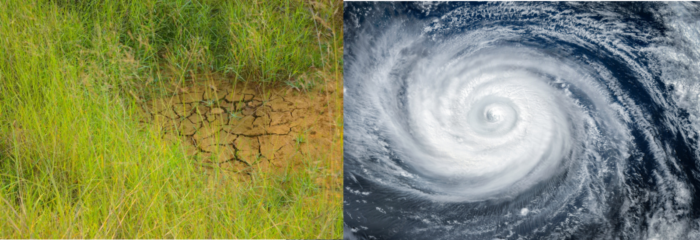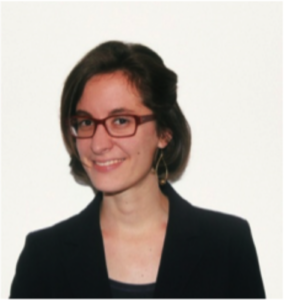
Answering disasters triggered by natural hazards is a profoundly political process; who can tell us about this is Isabelle Desportes with her study cases of Ethiopia (the 2016 drought), Myanmar (cyclone Komen in 2015) and Zimbabwe (the 2016/2019 drought).
 Today, I have the pleasure of interviewing Dr Isabelle Desportes, a researcher who approaches disaster risk governance from the angle of political science and sociology.
Today, I have the pleasure of interviewing Dr Isabelle Desportes, a researcher who approaches disaster risk governance from the angle of political science and sociology.
Dr Isabelle Desportes is an Associate Researcher at the Disaster Research Unit, Free University Berlin. She works on the BMBF-Project: ‘Tsunami Risk: Multi-Risk Assessment and Cascade Effect Analysis in Cooperation between Indonesia and Germany – Collaborative Research on Volcano – and Landslide – Induced Tsunamis’. Moreover, she is an Associate Researcher at the LAM- Les Afriques dans le monde at Sciences Po Bordeaux. Throughout her career, she worked as an applied researcher, project coordinator and consultant in institutions such as the International Federation of the Red Cross Red Crescent in Switzerland and the NGO-alliance Partners for Resilience in Ethiopia.
Current primary research of Dr Desportes focuses on early warning processes from a social science perspective, humanitarian aid and its depoliticisation, conflict studies and civil society mobilisation.
Hello Isabelle, thank you for letting me interview you! I usually work on risk assessment from a physical science perspective. When I first read about your research topic, I thought it could be very interesting for our readers and me to delve more into this topic. Can you briefly describe what it means to work on risk assessment from a social perspective?
Of course, thank you for the invitation! It is important to have inter-disciplinary discussions and even more so between social and natural scientists. So for me, as a social scientist, a risk assessment or a disaster impact assessment is never a neutral representation of reality. I try to see the process behind the output, be it a map, a graph or a table. The mapped space, in this case, is always linked to areas of knowledge production and decision-making. And in conflict-affected settings, knowledge building and decision-making are particularly contested. For instance, the drought assessment process in Zimbabwe, referred to as ZimVAC (Zimbabwean Vulnerability Assessment Committee), is generally presented as a multi-stakeholder endeavour involving government, international organisations and non-governmental organisations. Official ZimVAC enumerators go from village to village to collect data on the expected harvest and local market prices. Yet, my research participants and some of the very same donors funding the process have also described the ZimVAC results as “political findings” coming out of a “political body”. The same applies to the Belg (rainy season between February and May) assessment carried out every June after the rainy season in Ethiopia. In Addis Ababa, the latest district drought risk assessment maps hang in nearly every NGO office. They play an enormous role in directing aid towards specific areas and not others. That is why it is crucial to scrutinise: Which actors get to decide which data matters, how and by whom it is collected, and how it is analysed and presented?
“the state instrumentalises disaster response to further political goals in the interests of a few.”
I saw that your primary research focuses on the areas of authoritarian low-intensity conflict (LIC). Can you explain to us what a LIC area is? Why did you choose to study these particular areas?
Practitioners and policy-makers often treat disaster and conflict as two distinct entities. For instance, the Sendai Framework for Disaster Risk Reduction does not mention conflict, even though more than 30% of disasters occur in conflict settings, and conflict is a key driver for disaster vulnerability! The same separation often applies to research: there are disaster studies and conflict studies in social science. In my PhD research, I was interested in the interrelations between both. Studies on this exist, but they are mostly either large-N quantitative or single qualitative case studies. To complement this, the research programme I was part of, ´When Disaster meets Conflict’ [1], worked with several cases of three types of conflict: high-intensity conflict, low-intensity conflict, and post-conflict.
Low-intensity conflict, the type I studied based on fieldwork in Ethiopia, Myanmar and Zimbabwe, is generally understudied. It is less spectacular than, for example, a full-blown war in Yemen or Afghanistan. Yet, violence is highly present as well:
- Physical violence during protests and repressive clamp-downs,
- structural violence in the form of laws which, for example, discriminate based on gender or ethnicity, and
- cultural violence, which makes one believe that such violence is ´normal´ or even ´justified´.
These three types of violence have been described by sociologist Galtung [2], one of the founders of Peace and Conflict Studies. I found them to apply to disaster response processes in low-intensity conflict settings. Bureaucratic restrictions and a (state) monopoly on data collection and analysis processes are some of the ´everyday political´ ways in which power and violence can be exerted there.
“it follows that non-state disaster response actors prefer to socially navigate around or conceal politically sensitive issues, rather than to openly confront them.”
Were there any setbacks in your research so far? If yes, how did you handle them?
Research disaster risk reduction and response in conflict settings are always fraught with ethical dilemmas and surprises. You must be ready to re-adapt your plans; I have learned that lesson with time. It is important to constantly monitor your surroundings and how they evolve. In conflict settings, studying disasters is generally a bit easier since it is considered by so many as an apolitical, technical topic – that is precisely what I find fascinating about it. Why do so many practitioners, policy-makers and officials pretend it is not political, even though disaster vulnerability is caused by social and political processes, and even though disaster response can be a way to exert power and violence?
But still, the sensitivity levels attached to studying disasters can vary. One anecdote regarding that is how, before my fieldwork in Ethiopia, I had prepared business cards which stated ´humanitarian governance´ and not ´When Disaster meets Conflict´ as a research topic. In 2017, the Ethiopian conflicts hardly made the headlines let alone good discussion topics with government officials. ´Humanitarian governance´, on the other hand, seemed like a safe thing to study: what aid resources are dispatched and health- and other humanitarian activities carried out, where, based on which drought impact assessments.
When I arrived in Myanmar in 2017, however, I noticed that even ´humanitarian governance´ was too sensitive a term to be written on my business card. The so-called ´Rohingya crisis´ was reaching a high point, with intensifying violence towards the members of the Muslim ethnic minority, which were considered illegal immigrants by the Myanmar government and in mainstream public discourse.These shifting perceptions must all be navigated, whilst keeping in mind that accountability goes first and foremost to disaster- and conflict-impacted populations themselves. Humanitarian actors supporting the Rohingya, whom many regarded as ´the enemy from within´, were thus portrayed as ´enemies´ in turn. I am happy these days are over now, though, as my current research relates to the relevance of geoscientific research for practice in the context of early warning and non-seismically induced tsunamis. It is less hectic to do fieldwork on that!
“there are indications that non-state actors tend to ‘internalise’ a depoliticised approach.”
Is there something you’d like to see happening at the interface between disaster management and policymaking that hasn’t happened yet?
Much research is pointing at the ‘research and practice gap’, and I am very pleased to see more on that coming, specifically concerning geoscience, which is at the centre of my current research. One thing that strikes me is that we already know much of what should be done:
- involve practitioners and policy-makers from the start of a research project rather than parachute the findings to them once it is finished;
- not underestimate factors such as trust;
- work with local researchers as true partners with equal funding;
- work with knowledge brokers who have specific research communication skills.
Yet, too often, this is still not happening. We need to research why the already learned lessons are still not applied. The answers likely have to do with broader systemic factors, such as a university system that pushes for the quantification of outputs, including scientific articles, rather than the quality of processes, such as honest partnerships across research, policy and practice.
Thank you, Isabelle, for your availability!
References
[1] Hilhorst, D. 2021. Headed by Prof. Dr. D. Hilhorst at the International Institute of Social Studies, Erasmus University Rotterdam. See: https://www.iss.nl/en/research/research-projects/when-disaster-meets-conflict
[2] Galtung, J. 1996. Peace by Peaceful Means: Peace and Conflict, Development and Civilization. Oslo : London ; Thousand Oaks, CA: International Peace Research Institute; Sage Publications. See: https://sk.sagepub.com/books/peace-by-peaceful-means
Post edited by Valeria Cigala and Silvia De Angeli

Sandra Nijhof
Nice interview! The name of the professor in the References is Hilhorst (not Hikhorst). Small difference 😉
Joana Parente
Thank you Sandra. Already changed it =)